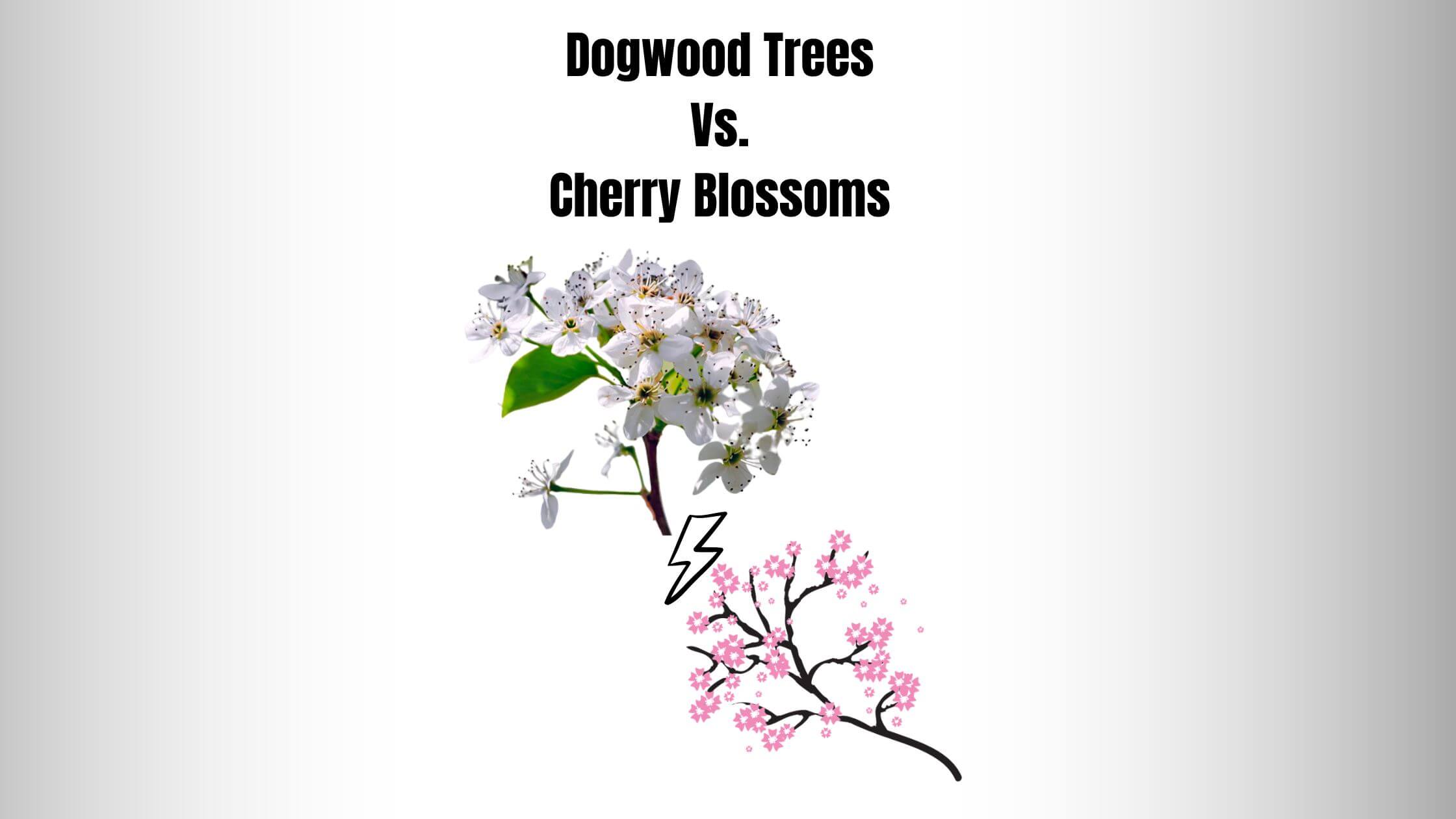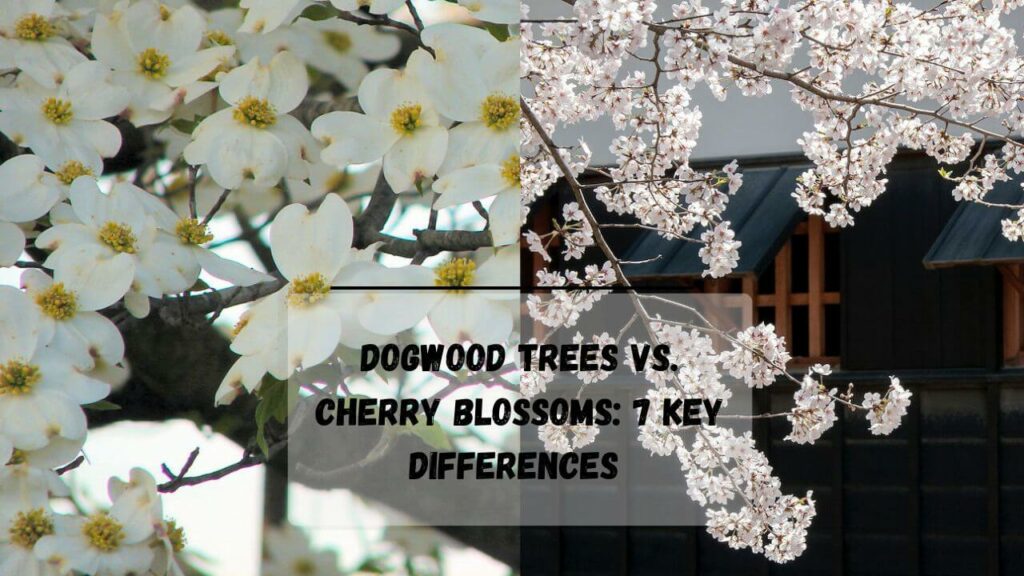
Dogwood Trees Vs. Cherry Blossoms: Since dogwood and cherry blossom trees are both popular as ornamental landscape additions, it can be difficult for beginners to differentiate them. This article will discuss seven significant differences between dogwood trees and cherry blossoms. Let’s first find out if cherry blossoms are related to the dogwood tree.
Are Cherry Blossoms Related To The Dogwood Trees?
No, cherry blossoms are not related at all. Both are entirely different plant species coming from other families. They don’t share any close family ties. Both make excellent ornamental trees with distinct differences in flower leaves growing habits and overall appearance.
Even though they look like distant cousins, they are very different when you look closer. Let’s take a closer look at the significant differences between dogwood trees and cherry blossoms.
Dogwood Trees VS Cherry Blossoms: 7 Key Differences

Appearance Size And Uses
You get different characteristics when it comes to knowing about a parent’s size and the tree species‘ uses. Dogwood trees come with a grounded spreading growth habit that can reach up to a height of 30 feet.
They can spread up to 25 feet, attract pollinators, and bloom clusters of aromatic flowers that occur in the spring. Dogwood trees have been frequently used for erosion control under stories trees in Woodland, gardens, and as a natural screen.
On the other hand, cherry blossoms usually have pyramidal growth habits, reaching up to 30 feet in height. They are also able to spread up to 1525 feet. With their delicate standing flower that blooms in the spring, there is also an excellent ornamental tree.
If you are looking for a tree that blooms in the spring, creating a beautiful display of white and pink blossoms, this is the one to have. In general, cherry blossoms are used as ornaments, specimens, streets, and even shade trees.
Soil Need, Growth Habit, And Adaptability.
The dogwood trees are adaptable to a wide range of soil, including alkaline, neutral and acidic, if proper conditions are given or provided. It is essential to keep them on the well-draining ground.
Since dogwood trees have a spreading growth habit, it is an ideal choice for overstories street or planting in groups for mass effect. It is also adaptable to a range of light conditions from full shade to full Sun, which makes them a versatile option for starting. On the other hand, cherry blossoms prefer acidic soil and good drainage.
As cherry blossom prefers growing upright, it is best suited to a location with total exposure to Sun. Even though they can be adaptable to many ranges of soil types, they heavily suffer from poor, drained soil or heavy rainfall.
If you are looking for a tree adaptable to a wide range of light conditions and soil, go with the dogwood tree, as they are versatile. Selecting a tree well suited to your growing needs in the region is also essential for the best result. Never mind consulting an arborist for better guidance.
Bloom Time, Leaves, And Propagation
Both dogwood and cherry blossom have different bloom times and propagation methods to consider; it is essential to learn what you are getting. Even though both are great trees that bloom in the spring and are attractive pollinators, there are different characteristics to consider regarding propagation method and bloom time.
The dogwood trees typically bloom in the early spring, and the cluster shows flowers before the leaves emerge. The dogwood tree leaves will look oval to oblong in shape with a green, dark-green color texture.
It provides a nice contrast to the flower of the wood tree. You can propagate the dogwood tree by cutting, seeding, or division. The dogwood tree is relatively easy to grow from cutting or division.
On the other hand, cherry blossoms with their fragrant flowers may also appear before the leaves emerge and are very difficult to grow from seed. It usually occurs from leaves in an oval to a lounged shape with a bright green to dark green color.
Their leaves also provide a night contrast to the cherry blossom flower. It is better to propagate a cherry blossom tree by cutting. Don’t think of multiplying it by division, as it will be more complex than growing it from seed.
If we talk about what tree is easy to bear, the dogwood tree wood is the one. Cherry blossoms can also be easily propagated if the cutting method is used.
Salt Tolerance, Leave Retention, And Disease Resistance.
When it comes to salt tolerance, leaf retention, and disease resistance, cherry blossom trees and dogwood trees have unique weaknesses and strengths. It just depends on what you are looking for in a tree.
Generally, dogwood trees are considered a choice for salt spray or coastal environments. They are very tolerant of salt and known to have good leaf retention. They can hold on to their leaf well into the fall season, making them an exciting choice among landscapes and gardens with trees that lose their leaves.
Cherry blossom trees, on the other hand, are not as salt tolerant as dogwood trees. They’re also susceptible to damage if the salt spray is provided. They could also better retain their leaves for a very long time.
In the fall season, cherry blossoms are known to lose their leaves relatively rapidly. However, cherry blossoms are better than a dogwood tree if we talk about disease resistance.
Cherry blossoms are resistant to disease & pest, meaning it requires low maintenance from the owner’s side. Dogwood tree woods are also resistant to disease but can be susceptible to some insect pests and fungal infections.
It is essential to keep an eye out for signs of pest infestations, conditions, and other trouble to take appropriate steps with your dogwood tree as soon as any issue arises. When it comes to choosing between two, you should consider what environmental conditions you are going to work with.
Root System, Invasiveness, And Maintenance.
Talking about dogwood tree roots are moderate to fast-growing trees. Their root system is also not invasive, making it an ideal choice for planting in garden beds or near sidewalks. Cherry blossom trees, on the other hand, also have a fast growth rate.
But their root system can only be invasive if taken care of properly. Concerning maintenance, cherry blossom and dogwood tree is relatively low maintenance but can benefit from regular pruning to control their shape, size, and dead branches.
It would help if you considered regularly pruning damaged or crossing branches to keep your tree healthy. Pruning will also help you promote new growth with both of these trees.
Wildlife, Cultural Significance, and Commercial Value.
When it comes to knowing the wildlife, cultural significance, and commercial value of both cherry blossom trees and dogwood trees, both have different roles to play. Both provide food and shelter to many wildlife species, including squirrels, birds, and other mammals.
Both are also an integral part of many forest ecosystems. Talking about cultural importance and significance, the previous generation used the dogwood tree for many purposes, including medicine, industry, or landscaping.
Since it is hard and dense, people have been using its wood to make various tools and crafts. Culturally, cherry blossoms have a long history in many parts of the world. In Japan, cherry blossoms are considered a symbol of the fleeting beauty of life and renewal.
In terms of commercial value, cherry blossoms are valuable for their ornamental value and have been frequently used in parks, gardens, and other landscapes worldwide.
On the other hand, the dogwood tree comes with limited commercial value and has been frequently used as ornamental plants or decorative Woods only.
Whatever you choose, both will provide food and shelter to many wildlife species and provide ornamental value and cultural significance to your landscape.
Since trees have different roles in human culture and the environment, people prefer going with them.
Cost And Care.
When it comes to knowing sunlight requirement, fertilizer requirement, availability of varieties, cost, and their need for both trees, there are different things to consider. Dogwood trees prefer partially shaded to full sun locations to protect them from intense afternoon sunlight.
Keeping a dogwood tree in well-draining, moist soil is essential. You should only apply light fertilization in spring to promote healthy blooming. Many species of dogwood trees have different flower and foliage colors.
Dogwood trees are also relatively low, starting with a price tag of $50 only. Since they are also a common maintenance tree that benefits from occasional pruning to remove it’s damaged or crossing branches, people often avoid pruning them. You should always prune a dogwood tree from time to time and monitor it for signs of diseases at best issues.
Talking about the cherry blossom, they also prefer growing in the entire location. It will also benefit from some protection from strong daylight and cold temperatures. Consider mulching 1-3 inches at the base of your cherry blossom tree to retain its soil moisture and protect it from high or low temperatures.
Many species of cherry blossom vary in flower, age, size, and growth habit. It is also a moderately costing tree with a price range of $50. Since it is disease resistant, you don’t have to pay much attention to the signs of pests or diseases. However, regular pruning is essential to control its size, as their roots can be invasive if not held.
Conclusion
You learned from this article that dogwood trees are better in many aspects. If you want a treat with better soil and leaf retention, go with dogwood trees. However, cherry blossoms are better when it comes to resisting diseases.
Whatever you choose, both will add great beauty to your landscape while attracting many pollinators and wildlife species. Both trees will provide food and shelter to many wildlife species, inviting/promoting extraordinary fauna in your landscape.
If you find this article helpful, then consider sharing it. Your one share will help many people learn how to differentiate between the trees ‘cherry blossom tree and a dogwood tree. They almost look the same and share many similarities. Do check our other articles on dogwood trees. See you in the next post, till then take care and goodbye.
